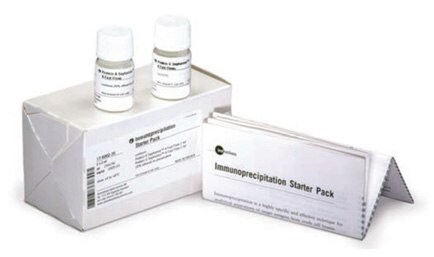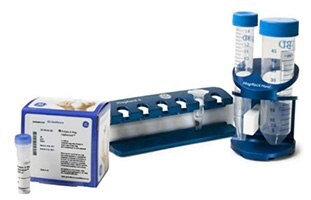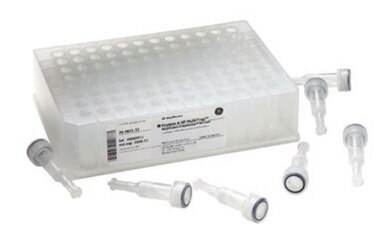Immunoprecipitation Techniques
Target proteins can be isolated and enriched from crude cell lysates by immunoprecipitation (also known as immunoaffinity or pull-down techniques). An antibody selected for its specificity is first affinity captured onto Protein A Sepharose or Protein G Sepharose chromatography media. In a second step, the immobilized antibody is used for capture and enrichment of the protein of interest (i.e., antigen). The target protein can be enriched several hundredfold, depending of the specificity of the antibody. In combination with other techniques, such as SDS-PAGE and immunoblotting, immunoprecipitation can be used to detect and quantitate antigens, determine relative molecular weights, monitor protein turnover and post-translational modifications, and check for enzyme activity.
By using the high specificity of protein A and protein G for the Fc regions of IgG molecules from a wide range of mammalian species, Protein A Sepharose and Protein G Sepharose chromatography media offer effective and rapid isolation and enrichment of such immune complexes.
Immunoprecipitation Starter Pack (Figure A3.1) from Cytiva is a good starting point for immunoprecipitation work. The pack includes nProtein A Sepharose 4 Fast Flow (2 mL) and Protein G Sepharose 4 Fast Flow (2 mL) to enable work with a wide range of antibody species and selection of the optimal medium.

Figure A3.1.Immunoprecipitation Starter Pack for immunoprecipitation of a wide range of antibodies with different binding selectivities.
Protein G Mag Sepharose and Protein A Mag Sepharose (Figure A3.2) combine well-proven enrichment methods with the magnetic beads platform, which has excellent properties for small-scale sample preparation. Together with MagRack 6, a separation tool for six microcentrifuge tubes, up to six samples can be processed in parallel. Alternatively, Mag Rack Maxi can handle larger sample volumes of up to 50 mL.

Figure A3.2.Protein A or Protein G Mag Sepharose (left image) offer simple enrichment of target protein in small or large sample volumes (low microliter to high milliliter scale) by use of MagRack 6 or MagRack Maxi (center and right images).
Procedures for immunoprecipitation must often be optimized empirically to obtain satisfactory results. For example, the choice of cell lysis conditions is critical with regard to cell type and how the antigen is to be used. Whereas cells without cell walls (e.g., animal cells) are easily disrupted by treatment with mild detergent, other cells might need some type of mechanical shearing, such as sonication or Dounce homogenization.
Refer to Table 3.1 in Chapter 3 to see which medium is likely to be suitable for the antibody source and subtype, or test using Immunoprecipitation Starter Pack.
Cell Lysis Conditions
Cell lysis must be harsh enough to release the target antigen, but mild enough to maintain its immunoreactivity. Some commonly used lysis buffers are listed in Table A3.1.
NP-40 (IGEPAL™ CA-630) and RIPA buffer release most soluble cytoplasmic or nuclear proteins without releasing chromosomal DNA and are a good choice for initial experiments.
Parameters that affect the extraction of an antigen include salt concentration (0 to 1 M), nonionic detergents (0.1% to 2%), ionic detergents (0.01% to 0.5%), and pH (6.0 to 9.0).
Choice of antibody
Polyclonal serum contains antibodies against multiple epitopes of an antigen. These antibodies help to stabilize the antigen-antibody-medium complexes, but can also create problems with high background during analysis.
Monoclonal antibodies (MAbs) are more specific, which reduces background, but can lead to the formation of less stable immune complexes due to lower affinity. This can be overcome by using pools of different MAbs.
Protein enrichment

Figure A3.3.Protein A HP SpinTrap spin columns and Protein A HP MultiTrap 96-well plates for the enrichment of proteins from a variety of biological samples.
Cytiva protein A and G products (Protein A HP SpinTrap, Protein G HP SpinTrap, Protein A HP MultiTrap, and Protein G HP MultiTrap, as well as Protein G and Protein A Mag Sepharose) are designed for small-scale protein enrichment, for example for use upstream of gel electrophoresis, liquid chromatography, and mass spectrometry (Figure A3.3). There are two alternative protocols for protein enrichment using these products: the cross-link protocol and classic protocol.
In the cross-link protocol, antigen-capturing antibodies are covalently bound to the Protein A or Protein G Sepharose chromatography media by a cross-linking agent. The antigen is enriched from the sample, purified through washings, and eluted from the column whereas the antibody remains bound to the matrix.
Use the cross-link protocol if the desired protein/antigen has similar molecular weight as the heavy or light chain of the antibody, which causes problems with co-migration in SDS-PAGE analysis or if the antibody interferes with downstream analysis.
In the classic protocol, antigen-capturing antibodies are immobilized by binding to protein A or protein G coupled to Protein A or Protein G Sepharose chromatography medium, respectively. The bound antibody is then used for capture of the antigen of interest. The classic protocol requires that the capturing antibody used binds to protein A or protein G. The antigen of interest is enriched from the sample, purified through washings and eluted from the column or the magnetic bead media together with the antibody.
The optimal parameters for protein enrichment are dependent on the specific antibody-antigen combination. Optimization can be required for each specific antibody-antigen combination to obtain the desired results. Examples of parameters that might require optimization are sample pretreatment, amount of protein to be enriched, incubation time, choice of buffers, and number of washes.
如要继续阅读,请登录或创建帐户。
暂无帐户?